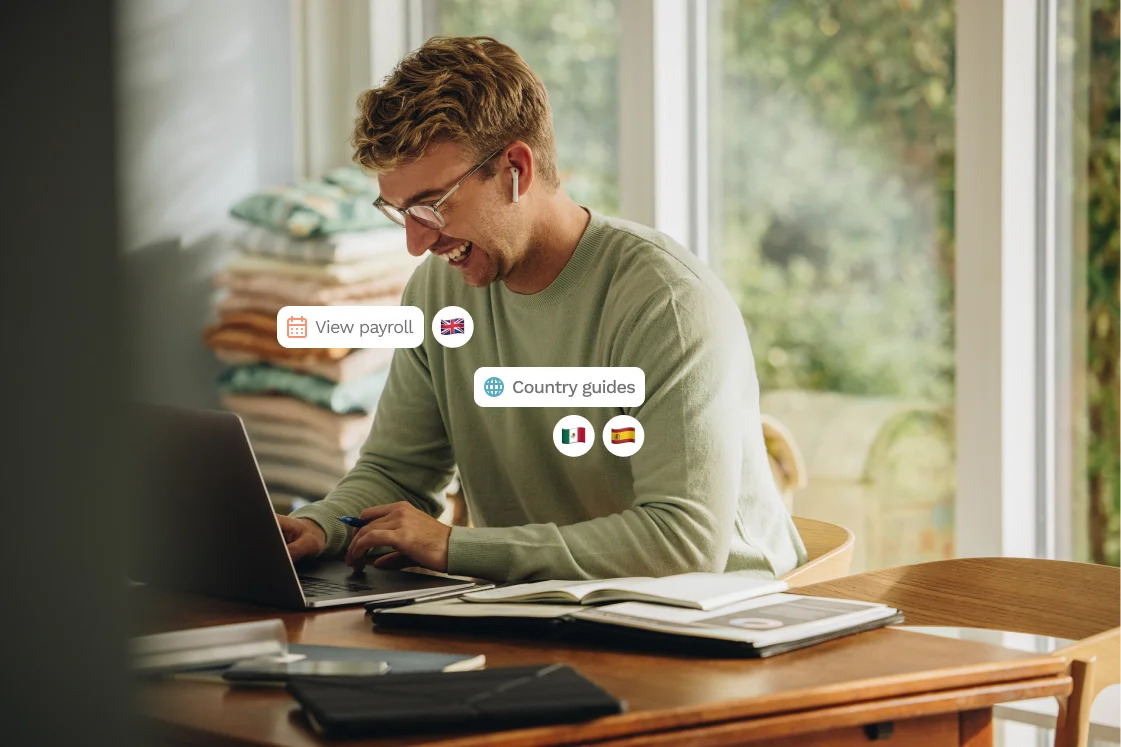If your business is expanding into new markets internationally or hiring employees abroad, you typically have two solutions to simplify HR, payroll, and compliance: an employer of record (EOR) or a professional employer organization (PEO). However, EORs and PEOs serve different needs.
This guide breaks down the key differences between EORs and PEOs so you can choose the right model to support your global hiring strategy.
What is an EOR?
An EOR is a third party that legally employs workers on behalf of another company. It allows businesses to hire full-time employees in other countries without setting up a local legal entity, saving time, reducing costs, and minimizing compliance risk.
This makes EORs valuable for global companies looking to expand quickly and compliantly across borders. Your company directs the employee’s day-to-day work and the EOR handles the legal and administrative responsibilities tied to employment and labor laws in the team member’s country.
An EOR manages essential HR and compliance tasks, including:
- Country-specific onboarding: This process guarantees every new hire is onboarded with their country or region's legal, cultural, and procedural requirements. This extends to any regional employee contract laws and ensures that the employment relationship starts smoothly with a consistent and well-organized experience.
- Payroll processing and compliance: Localized payroll processing means that the employee will be paid in their local currency on time and according to local laws. An EOR also keeps your business compliant with labor laws and regulations around wages, overtime, deductions, and record-keeping.
- Taxes: An EOR will handle withholdings and remittance of the appropriate income taxes, social contributions (e.g., Social Security and Medicare in the United States), and employer taxes as local regulations require.
- Benefits administration: Your EOR will manage statutory benefits and can offer access to supplemental health insurance, pensions, or other locally relevant benefits.
- Unemployment claim reporting: The EOR supports proper documentation and reporting if an employee files for unemployment benefits, reducing risk and administrative burden.
By working with an EOR, companies can grow globally with less complexity, maintaining compliance in every market while allowing control over day-to-day operations.

What is a PEO?
A PEO partners with your business to manage many time-consuming HR responsibilities and tasks. PEOs use a co-employment model, where the PEO and the client company share the responsibility and liability of employing staff. The PEO services focus on HR administration, and your company controls day-to-day operations and employee management. A PEO isn’t a global employer or agent of record.
Partnering with a PEO can streamline internal processes, reduce administrative burdens, and give your business access to better employee benefits packages, which are sometimes provided when registering. However, it's important to note that your company is a co-employer alongside the PEO, so you share responsibility for compliance with local labor laws and regulations.
A PEO typically provides support across several HR functions, including:
- Payroll: Processes employee pay, handles wage deductions, and ensures timely payment in line with applicable laws.
- Benefits administration: Offers access to health insurance and retirement plans and manages enrollment, renewals, and ongoing support.
- Regulatory compliance: Helps ensure HR compliance, including labor laws, wage regulations, and workplace policies.
- Tax filings: Manages the filing of employment taxes, including payroll and unemployment taxes, on behalf of your business.
PEOs are best suited for domestic operations where your company is already registered to do business. They can be an effective option for small to mid-sized companies that want to offer competitive benefits and streamline HR.
EOR vs. PEO: 5 differences you should know
Choosing between a PEO and an EOR can be daunting. They both support HR functions, but the responsibilities, legal structures, and use cases vary significantly.
Understanding the key differences between an EOR and a PEO can help you make sense of things and guide your decision.
1. Employment structure
An EOR becomes the legal employer of your team members on paper. This means they handle employment contracts, payroll, taxes, and compliance in each country where you hire—without requiring you to set up a legal entity.
In contrast, a PEO operates under a co-employment model. Your company and the PEO share responsibility as co-employers, which means you must be registered to do business wherever you hire. The PEO handles HR administration, benefits, and payroll, but you are still legally liable as a co-employer.
2. Liability
With an EOR, the provider assumes full responsibility for compliance, tax filings, and employment law in the employee’s location. That includes legal liability for payroll errors or labor disputes.
A PEO, however, shares liability with your company. While they provide guidance and ensure compliance, you still share legal responsibility for your team members.
3. Team type
EORs are ideal for managing international or remote employees in countries where you don’t yet have a legal presence. It’s a fast, flexible option for expanding into new markets or hiring a few key people abroad.
PEOs are best suited for building teams in countries or jurisdictions where your business is registered and operating. They’re often a good fit for companies with an established presence and a growing team that needs outside HR support.
4. Geographic coverage
An EOR allows you to hire in dozens of countries without setting up subsidiaries, making it the more scalable solution for global hiring.
PEOs limit their services to regions where your business is legally established. You can’t use a PEO to employ talent in a country without having a local entity.
5. Cost
EORs typically offer services in an all-in-one package, covering employment, payroll, compliance, and benefits with a transparent monthly fee.
PEOs may charge lower upfront costs, but you’ll likely face additional benefits, insurance, and legal support expenses. If your needs change, these add-ons can add up fast.
PEO partner or EOR partner: Which is right for you?
Choosing between a PEO and an EOR depends on where and how you plan to grow your team. Both models support essential HR functions like payroll, benefits, and compliance, but your business goals, legal setup, and hiring plans will determine the best fit.
Ask these key questions to help decide.
Do you have a registered business entity in the employee’s country?
A PEO may be the right fit if you already have a legal entity in the country where you’re hiring. It allows you to outsource HR functions and share the responsibilities and liabilities of the employment relationship.
If you don’t have an entity and don’t want to set one up, you’ll need an EOR to act as the legal employer on your behalf. This makes hiring full-time talent in new markets easy without the time and cost of establishing a local presence.
How many team members are you planning to hire?
PEOs often require a workforce of five or more employees, which can make them less suitable for early-stage hiring.
EORs work well for companies hiring just one or two employees in a new country or testing a market before committing to larger expansion. Their flexibility makes them ideal for smaller hiring initiatives or distributed teams.
Are you looking to hire full-time staff or independent contractors?
If you're building a long-term, full-time team internationally, an EOR provides the necessary infrastructure to ensure compliant employment contracts, benefits, and taxes. An EOR can also make sure you don't misclassify employees, which can result in steep fines, and help you convert contractors to full-time employees as needed.
Build your global team with Oyster
Expanding internationally doesn’t have to mean navigating complex labor laws or managing multiple HR systems. Oyster simplifies global hiring by acting as your trusted EOR partner in over 120 countries, letting you onboard full-time employees quickly without the hassle of opening a local entity.
With Oyster as your partner, you gain access to local expertise, streamlined payroll, compliant contracts, and world-class benefits that allow you to attract and retain top talent—anywhere in the world. Whether hiring one team member or building a fully distributed workforce, Oyster helps you stay compliant while keeping the employee experience seamless.
Book a demo today to see how Oyster’s EOR solution can help you build a global team.

In a recent G2 guide to best EOR Platforms, Oyster was spotlighted as “Best for software companies looking for global HR operations with automation”, a recognition from G2 that underscores the Oyster's leadership in delivering seamless, compliant, and scalable international hiring solutions.
FAQs
What’s a direct EOR operating model?
A direct EOR operating model incorporates or registers its own entity in the country where it provides EOR services. For example, an EOR uses a direct model when its U.S. entity employs people in the United States to work for its client companies based in other countries.
What’s an indirect EOR operating model?
An EOR using an indirect operating model provides services in countries or jurisdictions where it isn’t incorporated by leveraging local partners. For example, if the EOR doesn’t have its own entity in Mexico, it might work with a local partner in Mexico to help its client companies hire talent there.
What’s a hybrid EOR operating model?
A hybrid model combines direct and indirect models. The EOR might have entities in some countries but use local partners in others. This model can help increase coverage geographically.
About Oyster
Oyster is a global employment platform designed to enable visionary HR leaders to find, engage, pay, manage, develop, and take care of a thriving distributed workforce. Oyster lets growing companies give valued international team members the experience they deserve, without the usual headaches and expense.
Oyster enables hiring anywhere in the world—with reliable, compliant payroll, and great local benefits and perks.
.webp)






